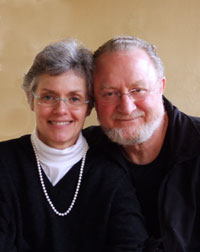The Green View /
Patricia and Conrad Cortellini
Observing the
Christmas ‘holy day’
 Have you ever given consideration as to how “holy day” became “holiday?”
Have you ever given consideration as to how “holy day” became “holiday?”
The change took place over an extended time and was gradual—almost imperceptible. Yet the workings of time transformed “holy day” into something completely different.
Sunday, Nov. 29, will mark the beginning of Advent—four weeks to prepare for the birth of Jesus as our King and Savior on the “holy day” of Christmas.
However, we know from the past, while visiting any store, that Advent is preceded, by at least four weeks, by the commercial world’s preparation for the “holiday” of Christmas.
“Beginning on the first Sunday of Advent, the liturgical season of Advent commences, opening a new year in our Church’s calendar. During the days of Advent, we are called upon to: prepare ourselves to worthily celebrate the anniversary of the Lord’s coming into the world as the incarnate God of love, to make our souls fitting abodes for the Redeemer coming in holy Communion and through grace, and to make ourselves ready for his final coming as judge, at death and at the end of the world” (cited from New Advent Catholic Encyclopedia).
Advent is an important and profound ritual of the Church which marks the beginning of a yearly cycle that celebrates our salvation in the life of Jesus Christ.
Beyond Mass and the Sacraments, it is observed by prayer, customs such as the Advent wreath, and reflection on the lives of the many saints whose feast days fall in the season.
It is about our personal, family and parish spiritual renewal. An experience which begins with Advent crests with Christmas and lingers until the Epiphany.
Many of us, Catholics and non-Catholics alike, have come to recognize that the Christmas decorations that take over the stores the day after Halloween begin eight weeks of the pre-Christmas season of the secular “holiday.”
It is difficult to see the spiritual in this season no matter how often we hear “Away in a Manger” and “The Little Drummer Boy” broadcast on the radio.
This “holiday” actually marks the close of the retail year and is often responsible for as much as 50 percent of the yearly revenues of many retailers.
It has evolved into a circus of mass consumption driven by a pervasive and seductive marketing campaign propagating the message, especially to our children, that our happiness is dependent on our getting more stuff.
It starts at Halloween, crests with the last shopping day before Christmas, and ends abruptly with the rollout of the spring collection and the Valentine’s Day candy on Dec. 26. Is our willing participation in this scenario not worthy of reconsideration?
There is another dimension to this that should give us further pause. According to Annie Leonard (Story of Stuff), 99 percent of all the stuff that is bought, sold and gifted—all the stuff of the Christmas “holiday”—ends up in the landfill within six months.
All the extraction of natural resources and its attended damage to the environment, the cutting of lumber and clearing of forests, the pollution and waste in the manufacturing, the energy of transportation, all are expended for naught. The sum product of this whole enterprise is a huge mountain of trash.
Happiness does not depend on stuff. As the “holy day” season approaches this year, consider breaking from the pattern of the world.
Limit the number of gifts—be frugal. Substitute quality for quantity and buy gifts that last. Give gifts of your own making. Give the gift of your time, and spread grace and joy to all you meet.
Keep Christmas holy.
Happiness will find you.
(Patricia and Conrad Cortellini are members of Christ the King Parish in Indianapolis.) †
 Have you ever given consideration as to how “holy day” became “holiday?”
Have you ever given consideration as to how “holy day” became “holiday?”